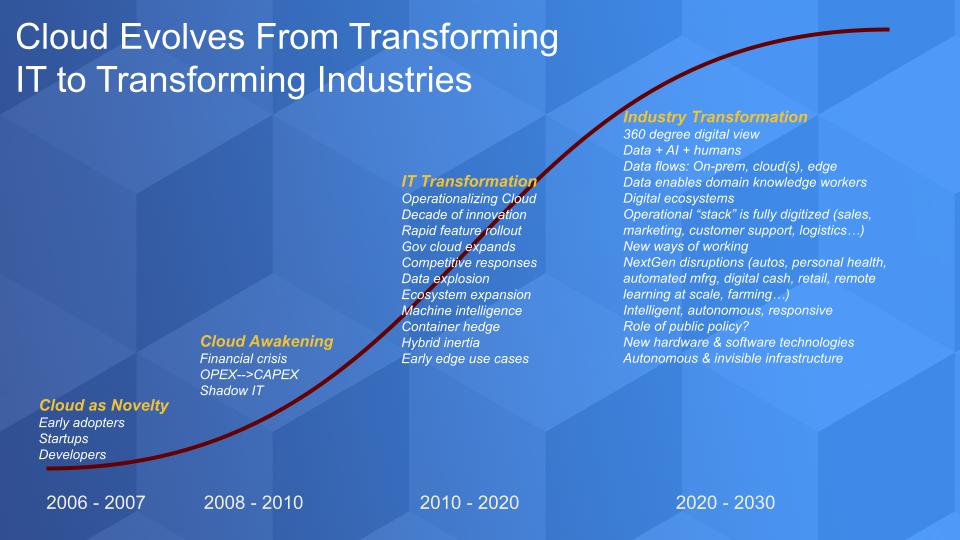 CLOUD
CLOUD
 CLOUD
CLOUD
 CLOUD
CLOUD
The race to cloud adoption has elevated the role of chief information officer from systems maintenance to critical strategist. True, the virtualization of the datacenter has relieved some of the CIO’s traditional burdens, but it’s hardly a fair exchange as decentralized hybrid cloud models become the norm.
CIOs are now tasked with delivering strategies that drive business results in today’s fast-paced, experience-centric and data-driven economy. Essentially, CIOs must ensure a full digital transformation agile enough to survive a pandemic.
How are CIOs managing this radical change, and what will be the lasting impact through the 2020s? During the recently concluded special event for theCUBE on Cloud, industry experts and chief information officers took a deep dive into the pressures CIOs face in 2021 and beyond. Here’s what they revealed.
After decades of innovation, the cloud has become an appealing and undeniable force that’s reshaped commerce and culture. From automation to machine intelligence, it falls to the CIO to expeditiously distinguish the most useful trends and minimize the complexities of merging systems of software.
“I’m seeing a lot of CIOs really saying, ‘OK, cloud is not just fashionable, but it’s a necessity,’” said Ana Pinczuk, chief development officer at Anaplan Inc., a software planning firm. “Frankly, the CIOs that don’t embrace the cloud and that level of agility are going to struggle. It’s really a personal imperative for a CIO, in addition to for the company.”
Sixty-one percent of CIOs say the COVID-19 pandemic increased their influence at their respective companies, according to a 2020 industry poll. Bearing this out, Pinczuk has experienced CIOs asking not only about digital transformation, but about problems specific to the 2020s, such as how to enable a remote workforce.
Companies now want the resilience to be able to recover and grow in inclement business climates, the agility to scale up and down or switch directions as needed, and fast innovation to create solutions that overcome new problems and take advantage of emerging hybrid opportunities, according to Pinczuk.
Doing this under the constraints of a single cloud strategy or vendor lock-in will be tough.
Hillery Hunter, vice president and chief technology officer of IBM Cloud, sees hybrid as the solution to the “random adoption of SaaS” that has occurred in some companies.
“People have ended up using cloud because there’s some SaaS function that they want or some particular line of business has been highly motivated to pursue some service on a particular cloud. And hybrid cloud is really about taking a step back, having a holistic architecture for cloud consumption,” said Hunter during her theCUBE on Cloud session.
From there, hybrid cloud can encourage multicloud, as “multicloud isn’t necessarily a strategy, it’s a reality,” she furthered.
Vendor lock-in “goes against the true spirit of hybrid cloud,” and deployments in different cloud environments happen “organically in many cases,” according to Hunter. She predicts the continued rise of distributed cloud as a “major trend” to bring visibility and control over those dispersed resources.
“Because if cloud is everywhere, if cloud is distributed and can be on-premises and in public cloud, it enables this consistency and this parity that brings together that seamlessness — not just the random acts of cloud usage,” she said.
Moving to cloud operations means serious changes companywide, and as the adage goes, “technology is easy; it’s the people and processes that are hard.”
Cloud reaches from the infrastructure all the way up the stack to provide those processes embedded in SaaS, according to Pinczuk.
“For CIOs, it’s upended how they think about business process re-engineering in their companies … so the role of the CIO relative to business process, in effect, changes. Now it’s about how to leverage a cloud infrastructure, and then how do you enable the customizations on top of that,” she said.
This is where CIOs at start-ups have an advantage over traditional companies that are burdened not only with legacy systems, but age-old processes and employees who are reluctant to change their accustomed way of work.
Born-in-the-cloud Pure Storage Inc.’s operations teams didn’t need to be convinced of the advantages of cloud adoption. “They saw it as an opportunity to really modernize, to really get themselves, both their own individual skill sets advanced, as well as provide a better level of service for our internal customer,” said Cathy Southwick, chief information officer at Pure Storage.
Micromanagement has no place in the modern workplace, according to Southwick, who said the role of a tech leader is to point the direction and step back. She went on to describe an “aha” moment in realizing how leaders can get in the way of cloud adoption.
“I saw more employees wanting to drive, and I needed to back out and just say, ‘Here’s where we need to go’ [and] let them drive us there,” she said during her session at the event.
One area of friction in cloud adoption is billing. Chief financial officers who used to capitalize investments over years are now dealing with the unpredictable pay-as-you-go costs from cloud.
“You have to budget now for the maximum transactions you anticipate with a growth of a company,” said Dan Sheehan, an industry veteran who has held technical and operations roles in healthcare, insurance, retail, and food and beverage corporations. He predicts the trend for consumption billing will continue, creating an “interesting dilemma” for CIOs and CFOs.
“You’ve got to need to partner with your financial folks and come up with better modeling around some of these transactional services and build that into your modeling for your budget,” Sheehan advised in his session.
As COVID-19 solidified cloud for businesses’ financial survival, it has proven crucial to the evolution of entire industries. Instead of random deployment of virtualized infrastructure and as-a-service offerings, this “Cloud 2.0” will be a “more data-centric, real-time, intelligent, hyper-decentralized cloud that will comprise on-premises, hybrid, cross-cloud and edge workloads … [and] a services layer that abstracts away the complexity of the underlying infrastructure,” according to Dave Vellante, chief analyst of SiliconANGLE sister market research firm Wikibon and host of theCUBE on Cloud.

To meet this future, CIOs will need to create comprehensive strategies that leverage virtualized infrastructure, along with artificial intelligence, edge computing, the internet of things, 5G network capabilities, and above all, data, according to Vellante — all in the effort to be ever faster, more efficient, and provide customers and employees the level of intuitive experience they are demanding.
More insights on how CIOs can overcome the problems of today and prepare for the future can be found on theCUBE on Cloud event site. Power panels and sessions dig deep into the journey of cloud and include all the speakers listed in this article, as well as Mai-Lan Tomsen Bukovec, vice president of storage at Amazon Web Services Inc., who speaks about the future of cloud data storage; Rachel Stephens of RedMonk, who gives her perspective on navigating the complexity of software development tools in the cloud; John “JG” Chirapurath, vice president of Azure data, AI and edge at Microsoft Inc., who discusses simplifying cloud analytics in the 2020s; and theCUBE’s hosts sharing analysis and predictions for key trends, data and perspectives on cloud computing.
THANK YOU